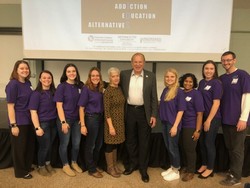November is American Diabetes Month, which was created to raise awareness for the continuously growing disease, according to the American Diabetes Association (ADA).
According to Kathy Maloney, Director of Health Services, “Type I diabetes (T1D) is also known as insulin-dependent diabetes. The body fails to produce enough of the hormone insulin, which is needed to metabolize sugar.” Maloney added that T1D is commonly a genetic disease, though that is not always the case.
Type II diabetes (T2D) is similar in that one’s body does not properly use the insulin that it makes. Also known as insulin resistance, T2D is a condition where the pancreas makes extra insulin to make up for the body’s misuse of the hormone. However, over time the pancreas cannot produce enough insulin to keep blood sugars at normal levels, according to the ADA.
Diabetes (T1D and T2D) affects 25.8 million people in the U.S., according to Maloney. Out of that number, one in 400 is less than 20 years of age.
Other lesser-known types of diabetes include pre-diabetes, which is what many adults develop before they are diagnosed with T2D. During this stage, blood sugars are higher than normal but not high enough to be diagnosed as T2D, according to the ADA. Patients can still prevent the onset of T2D at this point by losing 7 percent of their body weight (or 15 pounds if they weigh 200 pounds), or exercising moderately for 30 minutes a day, five days a week.
Another type of diabetes, gestational diabetes, develops during pregnancy. This usually occurs around week 24 of gestation and does not mean that a woman will have this disease after she gives birth according to the ADA. However, it is important to monitor the blood sugar closely for the duration of her pregnancy.
Maloney said that a person with diabetes requires external administration of insulin to help regulate their blood sugar levels. For those with T1D, insulin can be given through injections or through an insulin pump, which administers small doses of insulin throughout the day as opposed to all at once.
Animus Corporation, the company for one brand of insulin pump, said that patients who use insulin pumps are proven to have lower HbA1c levels (a measure of blood glucose levels over time) than those who take multiple injections of insulin daily. Insulin pumps also give patients the flexibility to sleep in, have more varying meal times and chose how and when to exercise.
Diabetes affects every patient differently. Kevin Holton, an English major, was diagnosed with diabetes at age two. “The human body is almost impossible to know well, so your insulin needs can change without warning,” said Holton. “Also, it frankly sucks having to break down every bite of food so you know what do give yourself. I’ve converted to vegetarianism just because it makes my numbers easier to control. I want to reduce the long-term damage as much as I can.”
Diabetes awareness is important in moving forward with medical research according to Kelsea Lowe, a Brookdale Community College student. “[Diabetes] is a life threatening chronic disease that, if left untreated, results in many complications and in severe cases, death,” said Lowe.
Diabetes can prevent people from living normal social lives as well. “Also, sometimes my insulin pump will stop delivering, usually when it’s most inconvenient, meaning I have to cut short whatever social event I’m engaged in. ‘Sorry, but I might die if I don’t leave right now’ is an awful way to end a date,” said Holton.
Complications from both types of diabetes can also cause long term complications such as heart disease, stroke, blindness, kidney disease or failure and nervous system disease according to Maloney.
According to the ADA, diabetes is the leading cause of blindness and kidney failure, accounting for 44 percent of kidney diseases. People with diabetes are also two to four times more likely to suffer from a stroke.
As of March, 2013, the national cost of diagnosed diabetes is $245 billion. Direct medical costs account for $176 billion and reduced productivity accounts for $69 billion according to the ADA.
Educating people about diabetes is important for more than just patients, according to Holton. He said that the three main reasons that awareness is important are, “To be aware so that [people] can be sensitive to the needs and differences of people around them, to be exposed to what is rapidly becoming a more widespread affliction and to be aware of warning signs in themselves and others.”
Lowe agreed that people should be educated about diabetes. She said that many people know what the disease is but do not know the difference between T1D and T2D.
Diabetes is a life-long disease that patients have to learn to manage according to Lowe. “You control the disease, the disease does not control you and it takes a lot of patience and control to manage the disease. It’s a very hard large balancing act,” said Lowe.
PHOTO TAKEN from wordpress.com




